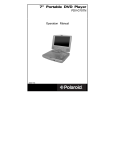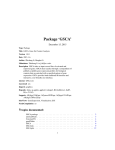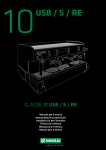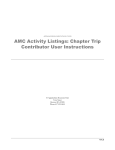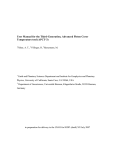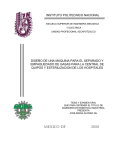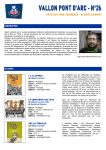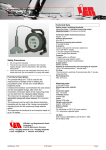Download Harpoon Free Fall Cone Penetrometer Test Results: Hudson
Transcript
Harpoon Free Fall Cone Penetrometer Test Results: Hudson 2004030 Field Verification Project Prepared for: Petroleum Research Atlantic Canada by Christian Situ Geosciences Inc. 1204-1414 Barclay Street Vancouver, BC, V6G 1J4 and Brooke Ocean Technology Ltd. 50 Thornhill Drive, Unit 11 Dartmouth, NS, B3B 1S1 October 06, 2004 INTRODUCTION This report summarizes field testing and geotechnical engineering interpretations for data collected with the Harpoon Free Fall Cone Penetrometer Test (FFCPT). This apparatus was developed with financial support from the Petroleum Research Association of Canada (PRAC) by Brooke Ocean Technology Ltd. and Christian Situ Geoscience Inc. Shiptime was provided by the Geological Survey of Canada Atlantic (GSCA) for testing purposes. The tests conducted during this cruise fulfilled a PRAC requirement for field verification of the technology, in preparation for commercial application. BACKGROUND The FFCPT method involves dropping an instrumented penetrometer into the seafloor, using its gravitational mass as a means of developing sufficient downward force to cause shear failure of the sediments. The FFCPT sensors are designed to record the decceleration and the porewater pressure response of the sediment during the penetration process. Geotechnical engineering data can be obtained from these measurements, useful in characterizing the sediment layering, composition and shear strength profile. Such data are required for design of deepwater suction pile foundations for tethered leg platforms and FPSO’s. The FFCPT yields geotechnical measurements that are directly comparable to conventional cone penetration test (CPT) methods, used in current site investigation practice by industry. Traditionally, these data have only been obtainable from specialized deepwater site investigation vessels. The long term objective of this project is to develop a commercially viable alternative method of geotechnical site investigation, that is deployable from a vessel of opportunity. EQUIPMENT AND METHODS The configuration in this project employed the GSCA large-diameter piston coring system as a delivery device. The FFCPT probe was mounted on the end of the core barrel in place of the cutting shoe. The FFCPT probe operates fully autonomously in this configuration, wherein system operational parameters such as trigger channel, trigger threshold, rearming channel, rearm threshold and data buffer characteristics are set at the 1 time of probe activation. The penetrometer is mounted on the end of the piston core barrel after the internal computer has been given a set of preset trigger thresholds and test parameters. Figure 1 shows two photographs of the instrument (a) on the bench being configured for testing and (b) being mounted on the core barrel, which is held horizontally at the ship’s rail. Figure 1a. Setting up the FFCPT on the bench in the forward lab onboard CCG Hudson during the July 2004 GSCA cruise to the Scotian Slope. Figure 1b. Mounting the FFCPT on the end of the GSCA large diameter piston corer at the rail, in preparation for deployment. 2 The probe houses electronics and hydraulic systems for sensing water pressure around the tip during penetration (dynamic porewater pressure), hydrostatic pressure at the top of the instrument (open to the water column), optical backscatter at a location just behind the conical point (mudline detector), as well as acceleration over 3 ranges (+/- 2g, +/- 5g, +/- 50g). Data is captured into two files after each trigger event. The system is activated to capture data initially into a low speed (25 Hz) buffer file. This file is later used to check calibration constants for the Tail Pressure gage. Once the system senses that the preset trigger condition has been met, it also begins logging data into a high speed (2 kHz) buffer. After the buffer is full (maximum duration of 20.925 sec) the system switches back to low speed and checks to see if it should rearm itself for another high speed data capture. Once the rearm condition is met, it will go into a standby mode, awaiting another trigger event. Triggering can be done off any of the channels, at any signal level. Similarly, rearming can be done from any channel, at any signal level. Ideally the system should be set so that it always remains armed for data capture following any trigger events. The data interpretation is done within custom FFCPT View software. Signal conditioning is done at this time. Each trigger event creates a set of datafiles, stored in Flash memory within the FFCPT probe. Upon recovery, the datafiles are offloaded using Windows HyperTerminal software to the host computer for processing, interpretation and hardcopy output. Two methods of deployment were used. For the first two stations (001 and 005) the system was lowered into the seabed on the winch, at maximum payout speed. However the data indicated that the dynamic strength profile of the sediment was not high enough to substantially decelerate the corer, especially near the mudline. The penetration ended when the corehead impacted the mudline, indicating that more core barrels should have been mounted. The last two tests (stations 013 and 015) were carried out by tripping the corer from a free fall height of between 2.4 and 4.0 m, using the pilot gravity corer as a trip weight. The resulting test data were of much higher quality and can be put through the full FFCPT analysis. A settling period of 45 seconds was allowed after impact, to ensure that the datafiles had been written to the Flash card and the probe was rearmed. Two pullout events were recorded (stations 0005 and 013), giving useful data on the sediment suction behaviour. Capturing pullout events is not an objective of the test however. Figures 2a and 2b show photographs of the FFCPT readied for deployment. 3 Figure 2a. FFCPT Mounted on the end of the GSCA large diameter piston corer at the rail, in preparation for lowering. Figure 2b. FFCPT on core barrel, ready for lowering. 4 Figures 3 shows a photograph of the piston corehead. Figure 4 shows the coring system being rotated to a vertical position and Figures 5 and 6 show the trip arm and gravity corer mechanisms being fastened to the wire at the corehead. Once deployed and allowed to impact the seafloor, the winch is used to recover the system to the ship. Once at the rail, the trip arm is removed from the wire and the corehead is lifted into its cradle. Then the entire piston coring system is rotated back up to the horizontal position for cleaning and removal of the FFCPT tool (Figures 7 and 8 ). At present, the FFCPT must be taken into the lab after each recovery to download the data. In future, data downloading will be possible at the rail. The entire operation is highly efficient and takes less time than is needed for taking a physical core sample. Since there are no core samples inside the core barrel, all that needs to be done is to download the data each time. There is sufficient capacity built into the FFCPT datalogger for conducting over 100 tests before recovery is actually required. This makes collection of in situ geotechnical data highly cost effective, especially at deep water locations, where lowering and raising operations can consume hours of shiptime. Figure 3. GSCA large diameter piston corehead with 30 ft. of core barrel and FFCPT. Tests were conducted with as much as 50 ft of core barrel. 5 Figure 4. GSCA large diameter piston being rotated to a vertical position. 6 Figure 5. Trip arm attached to the wire and the piston corehead, with 8 ft of free fall (note loop in recovery wire). The end of the recovery wire is attached to a sliding piston inside the core barrel, which allows the system to fully penetrate the seabed. Figure 6. 3m gravity corer being attached to the end of the trip arm wire. This allows for release of the piston corer into free fall at the correct height (free fall distance) above the seafloor. A small sample is collected each time this corer is used. 7 Figure 7. FFCPT and 50 ft. of core barrel being raised to the rail. CCG Hudson can accommodate as much as 100 ft. of core barrel, using the dedicated monorail system (see top of photo). Figure 8. FFCPT after recovery, showing mud up to the split coupling on the core barrel, before being pressure-washed. 8 FIELD TESTING AND DATA INTERPRETATION Table 1 summarizes key data for the four FFCPT tests conducted during the GSCA Hudson 2004030 cruise to the Scotian Slope. Test 1 was unsuccessful because the trigger thresholds for high speed data collection were set incorrectly. The impact and penetration process only takes about 3 seconds, with 50 ft of core barrel (12 to 13 m of actual penetration). Test 2 successfully demonstrated that the system can be lowered into the seafloor using the ship’s winch and can achieve almost as the same amount of penetration as when the system is deployed in free fall, by tripping the piston corer (tests 3 and 4). The depth of penetration for test 1 was limited by the length of core barrels installed on the system (three 10 ft long barrels). The data record showed the corehead impacting the seafloor, which prevented deeper penetration. It is likely that had 5 barrels been installed, the ultimate depth of penetration would have been very similar to tests 3 and 4, wherein the system was deployed in free fall. Table 1. Summary of FFCPT test data for field trials onboard CCG Hudson during GSCA 2004030 cruise. SYSTEM CONFIGURATION STA NO. OF NO. BARRELS RIGGED 001 005 013 015 3 3 5 5 DEPLOYMENT DETAILS STA LATITUDE NO. AT IMPACT 001 005 013 015 44 41.8696N 42 50.0880N 42 33.0707N 42 44.2752N TEST RESULT SUMMARY STA APPARENT NO. PENETRATION (m) 001 10.4 005 10.4 013 13.2 015 12.0 PINGER TO CORER (m) CORER LENGTH (m) PINGER HT OFF BOT. @ IMPACT (m) TRIGGER CHANNEL TRIGGER LEVEL REARM DELAY (sec) REARM CHANNEL REARM LEVEL 30 30 NA NA 11.9 11.9 18.0 18.0 42 42 NA NA Mudline Diff Pr. Diff Pr. Diff Pr. 1,600 mV 3m 5m 5m 10 5 5 5 MUDLINE TAIL PR. TAIL PR. TAIL PR. 1,300 mV 2,000 m 3,000 m 3,000 m LONGITUDE AT IMPACT GEOGRAPHIC REGION LOCATION NAME JULIAN DAY PEN TIME 54 27.2130W 62 03.1020W 62 28.6169W 62 05.0831W Grand Banks Scotian Slope Scotian Slope Scotian Slope St. Pierre Slope Mohican Channel Torbrook Block Torbrook Block 193 196 198 199 1006 2009 1907 1955 WATER DEPTH (m) 1,013 894 1,581 1,200 WINCH SPEED (m/min) 97 97 TRIPPED TRIPPED FREE FALL (m) NA NA 2.4 4.0 VISUAL SEDIMENT DESCRIPTION FROM MUD ON OUTSIDE OF CORE BARRELS Very soft to soft silty clay, olive green Very soft to soft silty clay, olive green Firm over very soft to soft silty clay, olive green Firm over very soft to soft silty clay, olive green OBSERVATIONS OBS Rearm level set too low, probe triggered at rail, didn’t rearm Heave on ACC, DPT during penetration, try free falling corer Some false trigger events, good test, not at terminal velocity Some false trigger events, good test. not at terminal velocity 9 Data Interpretation After the datafiles were transferred to the host computer, they were processed and displayed within FFCPT View software (Version 3.1). This custom interface was written for analyzing FFCPT data collected with previous FFCPT models and is of limited usefulness in reviewing and displaying data collected with the piston coring FFCPT equipment due to system configuration variances. However, flat ascii files were created after signal conditioning was completed, then the geotechnical analysis and sediment behaviour interpretation was completed using spreadsheet methods. The interpretation of FFCPT data involves determining the descent velocity immediately prior to impact, then selecting the portion of the dataset containing the FFCPT penetration into the sediment, thereafter one of the acceleration channels is chosen and for forward integration against time, which yields the time-velocity curve (after impact). The integration process typically results in a non-zero residual velocity value, which is then used to adjust the impact velocity so that the at-rest velocity (integration residual) is reduced to zero. The velocitytime curve is then itself integrated, yielding the distance versus time curve. The depth at impact, as determined from the ship’s echosounder, defines the zero baseline for the Tail Pressure channel. The tip differential pressure is already compensated for hydrostatic pressure since its back side is open to the water column (inside the core barrel), so it is a direct high resolution measurement of the excess dynamic porewater pressure response to FFCPT penetration. Typically in very soft to soft clay, the dynamic porewater pressure response is in excess of hydrostatic, due to the low permeability of sediment surrounding the probe. The undrained shear strength is calculated from the dynamic penetration resistance, which is obtained from Newton’s Law (F=mA). A second, fully independent estimate of undrained shear strength is calculated from the dynamic porewater pressure. Both of these strength calculations utilize published empirical relationships developed from numerous analyses of static cone penetration test data. One long term objective is to develop greater understanding of the relationship between the CPT cone and pore pressure factors used in evaluating undrained shear strength, as it applies to tests conducted at high rates of penetration, as is the case with the FFCPT. To date, there seems to be very close agreement between the various cone penetrometers, especially with respect to the porewater pressure prediction of undrained shear strength. It is also possible to calculate a continuous profile of sediment type, by plotting FFCPT analysis parameters (excess pore pressure ratio and normalized dynamic penetration resistance) on a CPT classification chart, commonly known as a Bq – 10 Qn chart. Data from each test are plotted and each data point is assigned a numeric code, according to which region, or Sediment Behaviour Type, it falls into. This chart has been developed based on thousands of CPT soundings and sampled boreholes for which the soil classification was available. More experience is needed with FFCPT data before it can be concluded that the chart is also valid at high penetration rates. To date, there appears to be close agreement between FFCPT SBT predictions and actual sediment type based on grain size testing. Dynamic Penetration Resistance The FFCPT probe was mounted on the end of the piston corer and allowed to free fall into the seabed, to test the acceleration-based data interpretation method. Normally the FFCPT falls a considerable distance through the water column before impacting the seafloor and thereby achieves a constant terminal velocity, at which time by definition vertical accelerations are zero. This zero acceleration is equivalent to a free fall condition. However, with the Harpoon FFCPT configuration, there are large hydrodynamic drag forces that act on the piston coring head, which is not very streamlined. In fact, it appears that at the time of impact, the gravitational forces transmitted into the sediment were about half what they would have been had there been no hydrodynamic drag on the system. This is illustrated in the raw data times series depicted in Figures X and X, wherein the acceleration at the time of impact was about 50% less than 10 m/s2 (or 1g). This indicates that the downward gravitational forces are severely limited by hydrodynamic form drag on the corehead. A quick calculation indicates that the drag coefficient for the corehead is at best, 0.5 at the time of impact. Taking into account an acceleration baseline at impact that is less than 1g, a slight modification to the data analysis was required. The algorithm for integrating the area beneath the acceleration-time curve used a straight-line varying baseline, drawn between the measured acceleration at impact and that when the system had come to rest (by definition 1g). This adjustment in the analysis consistently yielded an accurate calculation of the total depth of penetration, which was compared to measured mud marks on the outside of the piston core barrel. The calculation of dynamic penetration resistance was likewise modified to shift the starting acceleration to be equal to 1g, as otherwise negative forces result from the data processing. An equivalent interpretation would also work, wherein all acceleration data are referenced to 0g instead of 1g. For the purpose of this testing, the former adjustment was made. 11 Dynamic Porewater Pressure Response The dynamic tip pressure response measured just behind the probe tip shows a deceleration effect in tests at locations FFCPT-013 and FFCPT-015, somewhat masking the sediment-induced excess porewater pressure response. This effect is due to water hammer surging on the negative side of the differential tip pressure transducer diaphragm, which occurs during free fall penetration. The dynamic pressure response is much more linear when the system is lowered into the sediment on the winch, rather than allowing it to free fall into the sediment. This is more typical of cone penetration test results, wherein soundings have consistently shown a gradual increase in shear strength with depth. The dynamic porewater pressure response is directly related to the undrained shear strength in clays, according to extensive testing over 25 years of CPT testing practice. It may be possible to significantly reduce the water hammer effect during free fall penetration, by installing a water surge chamber on the negative side of the differential tip pressure transducer. This would hopefully result in datasets that more accurately reflect the in situ shear strength profile. Replacement of the differential gage with an absolute gage would not be feasible, as the reduction in sensor sensitivity would have a degrading effect on the pressure measurement data. Figures 9 through 16 show interpreted results for the FFCPT tests summarized in Table 1, in graphical format. The raw data time series are shown, along with interpreted geotechnical engineering logs and sediment classification charts. Figures 9 and 10 correspond to a test where the coring system was winched (lowered) into the sediment column. The subsequent figures 11 through 16 show results from the following two tests which were done by free falling the coring system into the seafloor. The system operated well and had no electronic or mechanical problems. It was concluded that the best trigger method was to use the tip differential pore pressure channel, set to a trigger threshold of +5 m in head. Rearming was best done using the Tail Pressure (water depth) channel, set to a value much greater than the maximum water depth, which ensured that the system rearmed itself after all trigger events. The maximum operating range of the equipment is 3,400 m however the maximum water depth encountered was only 1,581 m. In general the sites tested comprised soft normally consolidated silty clays to clays, in some cases there was a stiff layer present at the seafloor, extending to several metres in thickness. The differential porewater pressure measurements were used to evaluate the undrained shear strength profile. The dynamic penetration resistance profile was calculated from the vertical acceleration data 12 and was also used to predict the undrained strength profile. Sediment Behaviour Type (SBT) was predicted from CPT classification charts, based on the combined dynamic penetration resistance and dynamic pore pressure response. 13 Raw data time series for FFCPT-005 location. The tool was lowered into the seabed at a rate of 97 m/min using the ship’s foredeck winch. Note the cyclic acceleration response, which is due to vessel heave effects transmitted down the deployment wire. The system came to rest at about 8 sec. Chris ian Situ OPTICAL OUTPUT (counts) GSC ATLANTIC HUDSON 2004030, STATION 005, MOHICAN CHANNEL, SCOTIAN SLOPE FFCPT-005 DAY 196 TIME: 2009 WATER DEPTH: 894 m 1200 MUDLINE DETECTOR 1000 800 600 400 200 0 0 1 2 3 4 5 6 7 8 20 -15 15 -10 10 -5 5 0 0 VELOCITY (m/s) 2 ACCELERATION (m/s ) 2g ACCELEROMETER 5 0 1 2 3 4 5 6 7 8 0 PRESSURE HEAD (m) Figure 9 5 10 15 20 25 DIFFERENTIAL GAGE 30 0 1 2 3 4 5 6 7 8 TIME (sec) 14 Figure 10. Summary interpreted engineering log for FFCPT-005 location. As the system was not deployed in free fall, no useful acceleration data was obtained (note NA comments on Qd, Bq and Qn logs. Chris ian Situ GSC ATLANTIC HUDSON 2004030, STATION 005, MOHICAN CHANNEL, SCOTIAN SLOPE FFCPT-005 DAY 196 TIME: 2009 WATER DEPTH: 894 m DYNAMIC PENETRATION RESISTANCE Qd (kPa) 0 0 100 200 300 0 DYNAMIC PORE PRESSURE Ud (m) 10 20 UNDRAINED SHEAR STRENGTH Su (kPa) 30 0 10 20 DYNAMIC PORE PRESSURE PARAMETER Bq NORMALIZED DYNAMIC PENETRATION RESISTANCE Qn 30-1.6 -0.8 0.0 0.8 1.6 0 200 DESCENT VELOCITY OBS & ACCEL. OUTPUT SBT V (m/s) (A/D counts) 400 0 -5 -10 0 500 1000 ρs = 17 kN/m3 1 Su / P' = 0.3 DEPTH BELOW SEABED (m) 2 3 4 5 6 NA NA VERY SOFT TO SOFT SILTY CLAY TO CLAYEY SILT NA 7 8 9 10 Uo 11 12 MAXIMUM DEPTH: 10.4 m N.C. Line COREHEAD ARRESTED PENETRATION PAST THIS DEPTH 0 10 2 A (m/s ) 20 15 Figure 11. Raw data time series for FFCPT-013 location. The tool was deployed in free fall using the piston coring trip arm, with a free fall distance of about 2.4m. The accelerometer data show the deceleration response as the system penetrates the seabed, coming to rest at about 3 sec. Chris ian Situ 1200 MUDLINE DETECTOR 1000 800 600 400 200 0 0 1 2 3 50 -10 50g ACCELEROMETER CALCULATED VELOCITY ACCELERATION (m/s2) 40 30 -5 20 10 0 VELOCITY (m/s) OPTICAL OUTPUT (counts) GSC ATLANTIC HUDSON 2004030, STATION 013, TORBROOK BLOCK, SCOTIAN SLOPE FFCPT-013 DAY 198 TIME: 1907 WATER DEPTH: 1581 m 0 -10 5 0 1 2 3 DIFFERENTIAL PRESSURE (m) 0 5 10 15 20 25 30 DIFFERENTIAL GAGE CALCULATED DEPTH 35 40 0 1 2 3 TIME (sec) 16 Figure 12. Summary interpreted engineering log for FFCPT-013 location. Note the large excess porewater pressure response from about 7 to 11m, due to the water hammer effect. A thin stiffer layer was encountered from 0 to 2m below seabed, which was also observed in adjacent piston core samples. Chris ian Situ GSC ATLANTIC HUDSON 2004030, STATION 013, TORBROOK BLOCK, SCOTIAN SLOPE FFCPT-013 DAY 198 TIME: 1907 WATER DEPTH: 1581 m DYNAMIC PENETRATION RESISTANCE Qd (kPa) -1000 0 0 1000 0 DYNAMIC PORE PRESSURE Ud (m) 10 20 UNDRAINED SHEAR STRENGTH Su (kPa) 30 0 20 40 DYNAMIC PORE PRESSURE PARAMETER Bq NORMALIZED DYNAMIC PENETRATION RESISTANCE Qn 60-1.6 -0.8 0.0 0.8 1.6 0 50 DESCENT VELOCITY OBS & ACCEL. OUTPUT SBT V (m/s) (A/D counts) 100 0 -5 -10 0 500 1000 CEMENTED FIRM SILTY CLAY 1 2 ρs = 17 kN/m3 DEPTH BELOW SEABED (m) 3 Su / P' = 0.3 4 Ud, corr 5 VERY SOFT TO SOFT SILTY CLAY TO CLAYEY SILT 6 7 8 9 10 11 12 13 Uo MAXIMUM DEPTH: 12.3 m Ud N.C. Line -10 0 10 20 2 A (m/s ) 17 Figure 13. Raw data time series for FFCPT-015 location. The tool was deployed in free fall using the piston coring trip arm, with a free fall distance of about 4.0m. The accelerometer data show the deceleration response as the system penetrates the seabed, coming to rest at about 3 sec. Chris ian Situ OPTICAL OUTPUT (counts) GSC ATLANTIC HUDSON 2004030, STATION 015, TORBROOK BLOCK, SCOTIAN SLOPE FFCPT-015 DAY 199 TIME: 1955 WATER DEPTH: 1200 m 1200 MUDLINE DETECTOR 1000 800 600 400 200 0 0 1 2 3 50 -10 50 g ACCELEROMETER CALCULATED VELOCITY 30 -5 20 10 0 VELOCITY (m/s) 2 ACCELERATION (m/s ) 40 0 -10 5 0 1 2 3 DIFFERENTIAL PRESSURE (m) 0 5 10 15 20 25 30 DIFFERENTIAL GAGE CALCULATED DEPTH 35 40 0 1 2 3 TIME (sec) 18 Figure 14. Summary interpreted engineering log for FFCPT-015 location. Note the large excess porewater pressure from about 5 to 10m, due to the water hammer effect. A stiffer layer was encountered from 0 to about 1.5m, which was also observed in an adjacent piston core sample. Chris ian Situ GSC ATLANTIC HUDSON 2004030, STATION 015, TORBROOK BLOCK, SCOTIAN SLOPE FFCPT-015 DAY 199 TIME: 1955 WATER DEPTH: 1200 m DYNAMIC PENETRATION RESISTANCE Qd (kPa) -1000 0 0 1000 0 DYNAMIC PORE PRESSURE Ud (m) 10 20 UNDRAINED SHEAR STRENGTH Su (kPa) 30 0 20 40 DYNAMIC PORE PRESSURE PARAMETER Bq NORMALIZED DYNAMIC PENETRATION RESISTANCE Qn 60-1.6 -0.8 0.0 0.8 1.6 0 50 DESCENT VELOCITY OBS & ACCEL. OUTPUT SBT V (m/s) (A/D counts) 100 0 -5 -10 0 500 1000 CEMENTED FIRM SILTY CLAY 1 ρs = 17 kN/m3 2 Su / P' = 0.3 DEPTH BELOW SEABED (m) 3 4 5 VERY SOFT TO SOFT SILTY CLAY TO CLAYEY SILT 6 7 8 Ud,corr 9 10 11 12 13 Uo MAXIMUM DEPTH: 11.75 m Ud N.C. Line -10 0 10 20 2 A (m/s ) 19 DISCUSSION The key findings of the field testing are summarized below in Table 2. Overall, the equipment functioned as designed, was easily deployed and recovered and produced useful geotechnical datasets. Some further work is required to improve the quality of the data and to compare it to shear strength test results measured in high quality core samples (still in progress). Table 2. Summary of key testing objectives and findings, along with suggested actions to remedy perceived problems, either with the mechanical and electronic equipment, or with the method of data interpretation. Mechanical Issues System handling Corer rigging Split FFCPT coupler Split coupler fasteners Saturating hydraulic lines Saturating filter ring User manual Probe diameter Electronics Issues Battery pack Mounting split coupler on core barrel very difficult in rough seas; significant pinch hazard to fingers To obtain free fall, it was necessary to attach recovery to top half of split piston inside core barrel Robust Difficult to clean mud out of cap screws Enerpac hand pump gage needle seems prone to jamming Potential for oil to drain out of filter during deployment Good but needs improvement Large enough to prevent mud from contacting core barrel; friction on core barrel is minimized Install centering ring on top end cap, to guide FFCPT onto core barrel; fabricate custom web sling for chain falls to support FFCPT at rail Fabricate custom opencentre piston for FFCPT work, which allows more water flow and fits core barrel with no core liner Need external safety wire attached to FFCPT housing in case core barrel breaks Portable high pressure washer for cleaning off mud Drill out pressure port on dial gage, viscous mineral oil not allowing pressure to release Use viscous silicone oil instead of mineral oil Update as required; develop Job Safety Awareness procedures for all activities No action required Duration of battery Bench test to check battery life not known, battery life 20 Sleep feature Assembly - disassembly Data transfer pack easily changed Serial sleep cable cannot be used inside core barrel if piston is in use; probe has to be activated on bench, assembled and deployed before battery life dies Serial connection inside top end cap easily pulled apart during reassembly No communication cable inside core barrel when piston in use Data Interpretation Issues Mudline detector High frequency noise on Mudline Detector signal Accelerometers Movement of piston inside core barrel produces highfrequency noise on accelerometers Terminal velocity Not achievable with 4 m of free fall due to hydrodynamic drag effect Differential pressure Dominated by water hammer when system deployed in free fall FFCPT Interpretation Not properly Software configured for Harpoon system Install a manual switch on FFCPT probe to activate and put electronics to sleep Solder wires to end cap connector pins Carry probe into lab for data transfer; fabricate longer deck cable for connecting to probe at rail Evaluate electronics on bench; hardware modification as required Apply high-frequency filter to acceleration data Increase free fall to 10m; streamline corehead Install air surge chamber on negative side of differential pressure gage Modified FFCPT View software to produce special Harpoon View version REFERENCES Robertson, P.K. 1990. Soil classification using the cone penetration test, Canadian Geotechnical Journal, 27(1), pp. 151-158. 21 APPENDIX A HUDSON 2004030 FFCPT SUMMARY LOG STATION FFCPT-001 Datafile: HUD0100.b01 / Day: 193 / Time: 1006 GMT / Site: St. Pierre Slope The FFCPT was configured to trigger on the Mudline Detector at a level of 1,600 mV and rearm on the Mudline Detector at a level of 1,300 mV. The equipment was winched into the bottom at a speed of 97 m/s and penetrated to the corehead (10.4 m). There was no damage. The datalogger recorded one datafile (HUD0100.b01), which was created with the system still at the rail. The OBS signal levels in the datafile never fell below 1,343 mV, so the probe did not rearm after being triggered at the rail. In future the rearm level should be set as high as possible, so that it will always rearm. Testing on the bench showed that the response of the Mudline sensor is dependent on the reflectivity of the material near the OBS port. White paper and orange plastic were found to induce triggering (ie. signals exceeded the trigger threshold) however dark green rubber did not. The signal response of the detector has a peak in a certain wavelength of light, as indicated by previous datasets sometimes showing signals falling off to the baseline with penetration into darker-coloured sediment. It was concluded that the Mudline Detector could not be relied upon to trigger the probe, as the seafloor sediment colour is often quite dark. Bench testing in the shop should be done to determine the range of sensitivity of the mudline detector in various colours of sediment. The system penetrated soft clay and came to rest with the corehead at the mudline, so the penetration process was incomplete. STATION FFCPT-005 Datafile: HUD0504.b01 / Day: 196 / Time: 1935 GMT / Site: Mohican Channel The FFCPT was configured to trigger on the Tip Differential Pressure at a level of 3 m and rearm on the Tail Pressure at a level of 2,000 m. The equipment was winched into the bottom at a speed of 97 m/s and penetrated to the corehead (10.4 m). There was no damage. 22 The datalogger recorded 24 datafiles, some of which were created by false trigger events during lowering and raising through the water column. Several data records were obtained recording the impact event (HUD0504.b01), the system at rest in the seabed (HUD0505.b01 and HUD0506.b01) and the pullout event (HUD0507.b01). The rearming worked well and ensured the probe recovered into a ready state after each false trigger event. In future, the trigger level could be increased to 5 m to prevent false triggering. The data buffer split of 50 / 50 % was also too biased toward the pre-trigger data, in future deployments using the winch-in method a 20 / 80 split should be used, especially if more core barrels are mounted. The pore pressure response was very good however there was some surging due to vessel heave that was transmitted down the wire. This surging was also observed on the accelerometer signals, which did not vary much from 1 g until the corehead impacted the mudline. The weight of the system was carried on the wire up until that time, indicating that longer penetration was possible had more core barrels been in place. The system penetrated soft clay and came to rest due to friction buildup on the core barrels. The accelerometer signal will likely not be very useful in determining the depth of penetration, when the system is lowered on the winch in this manner. It may be advantageous to free fall the system with a longer core barrel, to generate higher decelerations for integration. However the tip pore pressure data are acceptable. STATION FFCPT-013 Datafile: HUD01332.b01 / Day: 198 / Time: 1907 GMT / Site: Torbrook Block The FFCPT was configured to trigger on the Tip Differential Pressure at a level of 3 m and rearm on the Tail Pressure at a level of 3,000 m. The equipment was rigged like a piston corer using the upper half of the split piston. A free fall distance of 2.4 m was used. The safety wire was removed. No water hose was used inside the core barrel. The system penetrated to 13.2 m. There was no damage. The datalogger recorded 41 datafiles, most of which were created by false trigger events during lowering and raising through the water column. Several data records were obtained recording the impact event (HUD01332.b01), the system at rest in the seabed (HUD01333.b01, HUD01334.b01) and the pullout event (HUD01335.b01, HUD01336.b01, HUD01337.b01). The system was triggered at 5 m on the differential gage and rearmed at 3000 m on Tail Pressure. A 50 / 50 % pre-trigger / post-trigger data buffer split exactly the impact event. The pore pressure response was very good with no vessel heave effect during penetration into the seabed. There was excessive hydrodynamic drag created by 23 the bullnose shape of the corehead, which prevented it from reaching terminal velocity before impact. Accelerations were slowly increasing toward 0.5g during the free fall period. The entire penetration through the sediment lasted about 3 sec. The system came to rest in soft clay largely due to friction buildup on the core barrels. A stiff layer several metres in thickness was noted at the mudline. STATION FFCPT-015 Datafile: HUD01503.b01 / Day: 199 / Time: 1955 GMT / Site: Torbrook Block The FFCPT was configured to trigger on the Tip Differential Pressure at a level of 3 m and rearm on the Tail Pressure at a level of 3,000 m. The equipment was rigged like a piston corer using the upper half of the split piston. A free fall distance of 2.4 m was used. The safety wire was not used. No water hose was used inside the core barrel. The system penetrated to 12.0 m. There was no damage. The datalogger recorded 14 datafiles, some of which were created by false trigger events during lowering and raising through the water column. Several data records were obtained recording the impact event (HUD01503.b01) and while the system was at rest in the seabed (HUD01504.b01) but none during pullout. The system was triggered at 5 m on the differential gage and rearmed at 3000 m on Tail Pressure. A 50 / 50 % pre-trigger / post-trigger data buffer split exactly the impact event. The pore pressure response was very good with no vessel heave effect during penetration into the seabed. Excessive hydrodynamic drag created by the bullnose shape of the corehead again prevented the system from reaching terminal velocity before impact. Accelerations were slowly increasing toward 0.5g during the free fall period. The entire penetration through the sediment lasted about 3 sec. The system came to rest in soft clay largely due to friction buildup on the core barrels. A stiff layer several metres in thickness was noted at the mudline. 24

























